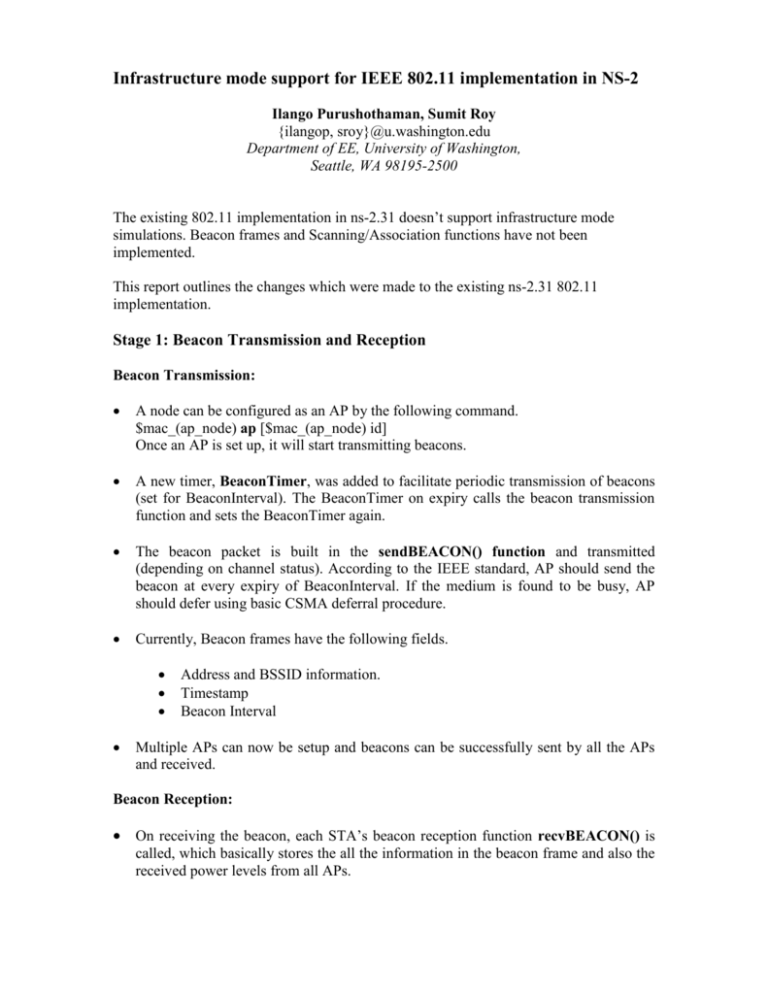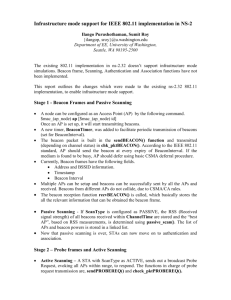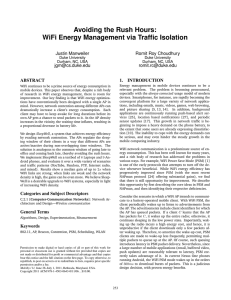Infrastructure mode support for IEEE 802
advertisement

Infrastructure mode support for IEEE 802.11 implementation in NS-2
Ilango Purushothaman, Sumit Roy
{ilangop, sroy}@u.washington.edu
Department of EE, University of Washington,
Seattle, WA 98195-2500
The existing 802.11 implementation in ns-2.31 doesn’t support infrastructure mode
simulations. Beacon frames and Scanning/Association functions have not been
implemented.
This report outlines the changes which were made to the existing ns-2.31 802.11
implementation.
Stage 1: Beacon Transmission and Reception
Beacon Transmission:
A node can be configured as an AP by the following command.
$mac_(ap_node) ap [$mac_(ap_node) id]
Once an AP is set up, it will start transmitting beacons.
A new timer, BeaconTimer, was added to facilitate periodic transmission of beacons
(set for BeaconInterval). The BeaconTimer on expiry calls the beacon transmission
function and sets the BeaconTimer again.
The beacon packet is built in the sendBEACON() function and transmitted
(depending on channel status). According to the IEEE standard, AP should send the
beacon at every expiry of BeaconInterval. If the medium is found to be busy, AP
should defer using basic CSMA deferral procedure.
Currently, Beacon frames have the following fields.
Address and BSSID information.
Timestamp
Beacon Interval
Multiple APs can now be setup and beacons can be successfully sent by all the APs
and received.
Beacon Reception:
On receiving the beacon, each STA’s beacon reception function recvBEACON() is
called, which basically stores the all the information in the beacon frame and also the
received power levels from all APs.
Stage 2 – Association Request and Response Frames – Passive Scanning
On receiving the beacon, each STA’s recvBEACON() stores the received power
level from each AP and the respective node ids, in a linked list. This list is updated
every time a beacon is received, to account for mobility of the nodes.
Passive Scanning – Each STA collects beacon information from all APs for a time
which is the maximum of all beacon intervals. Once it has collected all the received
power levels in the linked list, it picks out the “Strongest AP”.
Each STA sends out an Association Request frame to its Strongest AP, containing the
specific BSSID. The function sendASSOCREQ() builds the Association request
frame
and
the
actual
transmission
function
is
check_
pktASSOCREQ().
On receiving the Association request frame using recvASSOCREQ(), the AP sends
out the Association response, containing the Association ID. The functions used are
sendASSOCREP() and check_pktASSOCREP(). Basic CSMA rules are followed
by the AP for sending the Association response.
Right now, no decisions on Association, based on Supported Data Rates are made.
Each AP builds its own list of associated nodes.
On reception of Association response frames, using recvASSOCREP(), each STA
sets its own “associated” flag and sends an acknowledgement to the AP. It can now
transfer data packets in the BSS.
Clients of the same BSS/different BSSs can exchange data, and the APs of the BSSs
perform forwarding. Even if a connection (UDP, TCP etc) is setup between two
clients of the same BSS, data will be forwarded through the APs only. Inter-AP
communication has been implemented using the four different address fields and
ToDs and FromDs bits (using the same channel used by the clients).
Passive Scanning can be turned off by the following command
$mac[$i] scanning OFF for all STAs.
STAs will just receive beacons and will not initiate any association procedure.
Caveats:
Inter-AP communication, using a separate distribution medium, has not been
implemented yet. Inter-AP communication, for now, is achieved by using the same
wireless channel used by the clients, but special address filtering makes sure that only
APs can receive these “distribution frames”. Typical scenarios that would work with
the current implementation are: Clients can exchange data within the same BSS/
different BSSs. Client – Client communication, where the clients belong to different
BSSs, works as: Client1 –> AP1, AP1 -> AP2, AP2 -> Client2.
Authentication frames have not been implemented yet.
Multiple BSSs can be set up in a single channel. Multiple BSSs can also be setup on
different channels (using different channel objects) but communication across
different channels is not possible for now. Due to lack of multiple interface support,
an STA cannot scan all the channels used in the ESS. Hence, for now, passive
scanning is limited to one channel only.
An example script “infra.tcl”, of two BSSs operating in a single channel is provided
in /tcl/ex/80211. This sets up a single AP in a single channel and each STA uses the
passive scanning procedure mentioned above to associate with the AP. This script
provides an example of Client-Client communication, where the clients belong to the
same BSS.
Another example script provided is “multiple_ap.tcl” where three APs are set up in a
single channel. This is an example of Client-Client communication, where the clients
belong to different BSSs. Inter-AP forwarding of packets can be observed here.
To see the beacons frames, please look for “BCN” packet type in the generated trace
file. Association Request and Response frames are marked by “ACRQ” and “ACRP”
respectively.
Client-Client data exchange, facilitated by the APs forwarding, can also be observed
in the trace file.
Stage 3:
Inter-AP communication problem needs to be addressed more thoroughly. A separate
wireless or wired distribution system needs to be implemented.
Authentication will be implemented.
Active Scanning needs to be implemented – Probe Request and Response frames.







